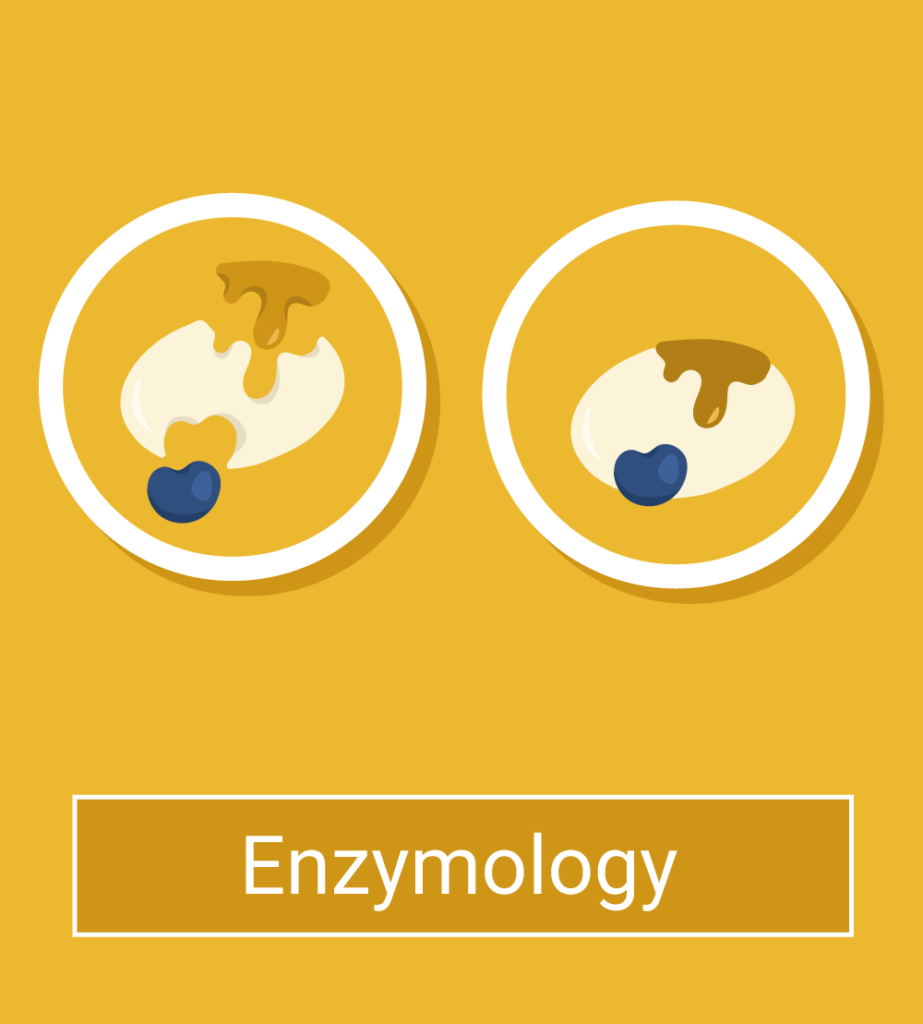

The term artificial enzyme loosely describes a molecule that attempts to imitate, recreate or modify naturally occurring biochemical reactions. Molecules are designed and modified to display enzyme-like characteristics.
For instance, artificial enzymes may mimic the catalytic ability and specificity of a well-characterized enzyme or catalyze non-naturally occurring chemical reactions using known mechanisms of enzymatic catalysis.
Catalysts facilitate non-spontaneous chemical reactions by lowering the activation energy and stabilizing the transition state. In catalyzed reactions, catalysts spontaneously react with molecules of the reactants to initiate the transformation of reactants into products.
After the reactants have transformed into products, they become free to interact with the excess reactant molecules, starting another round of catalysis.
Living cells in any biological system use enzymes as biocatalysts to accelerate the rate of naturally occurring chemical reactions.
They are proteins that interact only with specific reactants, referred to as substrates, and other regulatory molecules such as cofactors and effectors. These molecules must complement the three-dimensional structure and electrical charges of the enzyme catalytic and regulatory sites.
Enzymes are active only in narrow temperatures and pH ranges generally favorable to the corresponding organisms. Unlike inorganic catalysts, it is possible to control and change the rate and direction of enzyme-catalyzed reactions by manipulating the reaction setting and the abundance of the enzyme and substrate in the system.
Enzymes also have a high turnover rate even though typical enzymatic reactions occur in mild, aqueous conditions without extra heat or pressure added to the system.[1-2]
NB: Read more on factors that affect enzymatic activity here.
The effectiveness and environmental friendliness of enzymes have inspired scientists to create catalytic molecules that display similar characteristics.[3]
Artificial enzymes are structurally more complex than inorganic catalysts, although some are less sensitive to temperature and pH changes than natural enzymes. However, they may not necessarily be derived from chains of amino acids like enzymes, though they possess the substrate selectivity and specificity that amino acids provide.[4]
These enzymes first emerged with the term biomimetic chemistry in the early eighties. Ronald Breslow first used them to describe attempts to emulate the catalytic activity and functionality of known enzymes.
However, the term now has a broader meaning, covering the modification of enzyme functionality and application of enzymatic mechanisms.[3-5]
Enzyme mimics is a group of artificial enzymes that fit the definition of biomimetic chemistry, which display functional abilities resembling known natural enzymes.
The construction of enzyme mimics revolves around creating catalytic and other necessary binding sites on a suitable host molecule.[3-4]
Host molecules are soluble in water, and their three-dimensional structure typically contains a confined inner space. The host’s confined inner space accommodates the substrate, performing much the same role as the catalytic site of a natural enzyme.[4]
In the absence of the substrate, water molecules fill in the inner space of the host molecules. When the substrate is present, substrate molecules act as the so-called guest molecules and replace the occupying water molecules.
Only substrates that are complementary to the shape of the inner space and electrically compatible with the attached functional groups can access and occupy the inner space of the host.[4,5]
Like natural enzymes, an enzyme mimic’s host molecule shields the bound substrates from other molecules, preventing them from interacting with other non-targeted molecules while substrate-to-product transformation occurs.[4,6-7]
The earliest host molecule used to construct artificial enzymes is cyclodextrin, a water-soluble polymer that forms a supramolecular structure. It is made of cyclic glucose rings and shaped like a donut that has a hydrophobic inner space.[4-6]
The size of cyclodextrins varies, depending on the number of glucose molecules in the glucose ring. Thus, cyclodextrin-derived enzymes can accommodate hydrophobic substrates that fit the size of the cyclodextrin inner space.[5,7]
Other than supramolecular structures, complex molecules such as porphyrin cage and polypeptide chains serve as host molecules of artificial enzymes.[6]
To provide enzyme mimics with catalytic capability, functional groups that catalyze enzymatic reactions are attached to the host molecule.
Certain artificial enzymes may require additional functional groups at other sites that serve as binding sites to regulatory molecules, which influences the artificial enzyme activity when bound; this is similar to cofactors and effectors in natural enzymes.[4-5,7]
The placement of the functional groups is essential to the functionalization of host molecules. It includes, for example, the distance and angle between binding sites since functional groups play a role in determining the selectivity, catalytic activity, and the progress of enzymatic reactions.
Moreover, the functional groups bind to compatible substrates and other molecules and bind to the transition state and accommodate structural changes during the substrate-to-product transformation.[5,7]
As the earliest form of artificial enzymes, enzyme mimics have branched into various other forms. The following are words associated with enzyme mimics:
Designer enzymes are those enzymes derived from de novo enzyme design. In other words, designer enzymes do not mimic the catalytic activity of natural enzymes.
Instead, they are modified and created based on structural and functional information of several naturally occurring enzymes and insights into their catalytic mechanisms.
In brief, creating designer enzymes involves the following:[11-12]
In this step, the ideal mechanism of catalysis for the designated catalytic reaction is identified, including relevant functional groups that need to be modified or altered. This process simply involves generating the genetic blueprint of the first version of the designer enzyme.
Here, recombinant DNA containing the designer enzyme is created and transformed into host cells to express the first version of the designer enzyme, which is subsequently purified. Read more about genetic engineering here.
The purified designer enzyme is evaluated for the designated catalytic activity in the presence of its target substrate.
Also referred to as in vivo evolution, the designer enzyme is randomly mutagenized and screened for new variations with the most promising potential. Both processes are repeated until the variation displaying the most desirable catalytic activity can be identified.
De novo enzyme design is a popular approach to modify enzyme catalytic sites and catalyze non-naturally occurring chemical reactions.
One of the earliest examples of a designer enzyme is Merck-Codexis, used for the catalysis of Diel-Alder reaction, a final step in the large-scale production of sitagliptin, an active ingredient in the type 2 diabetes drug Januvia. At the time of development, no natural enzyme existed to catalyze such reactions.[11]
Traditionally, the last step in sitagliptin production involves an expensive rhodium-catalyzed reaction that requires additional purification steps to remove the heavy metal – rhodium.
To create designer enzymes that allow skipping that process, scientists selected a known natural enzyme that displays a desirable catalytic activity but is too small to accommodate the substrate. Using computational analysis, the amino acids that influence the size of the active site were mutagenized.
The initial designer enzyme went through several random mutation events using directed evolution before acquiring the designer enzyme with the designated functional activity.
As it turned out, the artificial enzyme-catalyzed route could avoid using rhodium as catalysts, reduce the produced waste and increase the overall product yield.[11]
This type of enzyme is the most recently developed approach. This approach is based on the idea that alterations in the characteristics of the enzyme’s building blocks will lead to changes in the enzyme’s inherent characteristics.[13]
Examples of artificial building blocks are:
Nucleic acids are not building blocks for proteins, but they serve as a template for RNA transcription and subsequent protein translation. Changes in the DNA sequence could lead to changes in the amino acid sequence.
Synthetic nucleic acids (XNAs) with unnatural backbones have reportedly been used as templates to express known enzymes. Reportedly, XNA-derived enzymes did not possess the exact amino acid sequence as that from natural nucleic acids.
Nonetheless, XNA-derived enzymes displayed comparable catalytic activity despite the predicted conformational change.[13]
Amino acids are the enzyme’s most basic unit. The sequence of amino acids determines the three-dimensional structure, which affords enzymes with their selectivity and specificity.
Incorporating non-canonical amino acids (ncAAs) into a protein will, therefore, affect the selectivity, specificity, and possibly, the enzyme’s catalytic ability.[1-2]
To date, two methods are used to create ncAAs: Selective Pressure Incorporation (SPI) and Stop Codon Suppression (SCS).
In SPI, manipulated transfer RNAs (tRNAs) carry ncAAs, which are structurally similar to normal amino acids. In an alternative method, SCS, tRNA with the non-preferring stop codons, and the associated translation mechanism are altered to carry the desired ncAAs.
Reportedly, ncAAs created from both methods can expand the enzymes’ functionality, including the addition of certain unnatural characteristics.[13]
Similar to the idea of ncAAs, artificial enzymes have been created using β-amino acids instead of the natural ɑ-amino acid. The main difference between the two amino acid species is the placement and distance between their functional groups.
Reportedly, the enzymes made from β-amino acid chains can catalyze an aldol reaction despite protein folding differences. The findings suggested the potential of β-amino acid-enzymes to serve as a substitution when natural enzymes do not function.[11]
Naturally occurring enzymes apply to the large-scale production of consumer products, especially in the food and pharmaceutical industries. Nevertheless, limitations in natural enzymes exist, and artificial enzymes show great potential to fill such gaps.
For instance,[3]
The effectiveness of natural enzymes has sparked the idea to emulate their characteristics and functionality. Early artificial enzymes are mostly enzyme mimics created based on the known natural enzymes.
The advancement of science and the understanding of catalytic mechanisms have made it possible to design artificial enzymes or synthesize ones from unnatural building blocks, expanding the existing catalytic capacity and catalyzing novel chemical reactions not previously catalyzed by natural enzymes.
All in all, efforts to create these enzymes can overcome the limitation of natural enzymes in their industrial applicability, foster our understanding of biological catalysis and promote sustainable consumption and production.
